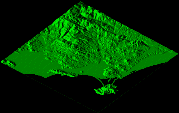
Digital elevation model of the survey region
This study presents some of the results of 18 years of research in the Albegna Valley/Ager Cosanus area, Tuscany, Italy. Thousands of artefacts have been collected and hundreds of sites recorded during this period by systematic field survey. The Albegna Valley/Ager Cosanus Survey was directed by Professor Andrea Carandini, now of the University of Rome, La Sapienza, and Professor Elisabeth Fentress, now of the American Academy at Rome. The project is a collaboration between scholars of many institutions in Italy, France and Britain and the first volume of the final report detailing and interpreting the sites located is now in press (Cambi et al, forthcoming).

Digital elevation model of the survey region
This study concentrates upon a part of the finds made during field walking: the ceramics dating to the Etruscan period (8th-3rd century BC). The collection largely consists of finewares, coarsewares and amphorae. Together with the study of the ceramics from the Etruscan city at Doganella (Perkins and Walker 1990), and the excavated Etruscan farm at Podere Tartuchino (Attolini and Perkins 1992), both also in the Albegna Valley, the present study forms the most extensive detailed study of Etruscan ceramics from settlements identified by systematic survey that has been made to date. Collections from individual sites have been published in the past but the Albegna Valley/Ager Cosanus is the first part of Etruria, investigated at a regional scale, where the Etruscan ceramics have been fully studied and published.

An Impasto holmos from the survey
The first part of the study is an account of the fieldwork and the sampling strategy which was used during the collection of the ceramics presented here. This is followed by a summary of the assemblage. The detailed catalogue of the survey finds follows and is extended by a catalogue of an out-of-context tomb group recovered during the survey. All the illustrations of the ceramics are interactive, forming a graphical interface to the data set. The full database of the ceramics is published with an interface enabling flexible and guided searching with output in the form of tables, linked to the text or as distribution maps. It is possible to perform geographical queries of the data from an interactive digital elevation model of the survey region. The concluding part of the study is an investigation of the distribution of the ceramics through the survey area and a consideration of consumption and production in the Etruscan period.
Go to Table of Contents
References
Perkins, P. and Walker, L. (1990) Field Survey of the Etruscan City at Doganella, Papers of the British School at Rome, 58, 1990, 1-144.